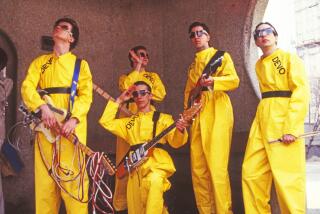POP MUSIC REVIEW : Dr. John Keeps It Pure, While Danko and Hudson Litter the Stage
- Share via
Mac (Dr. John) Rebennack and the Band’s Rick Danko and Garth Hudson all came to musical prominence in 1968, each offering roots-based alternatives to the lysergic thrash most groups were blasting out.
While Dr. John’s New Orleans-based swamp rock had more than a dollop of psychedelia mixed into it, the Band was drawing straight from the well, with tunesmithing worthy of a Stephen Foster and a musical style that ranged from the roots of country music to gritty R&B;, with touches of prairie carnival music thrown in for good measure.
That balance seems to have shifted over the years. Wednesday night at the Coach House, Rebennack’s solo set at the piano delivered about as much pure New Orleans as one can get without heading for Tchoupitoulas Street, while much of Danko and Hudson’s set seemed mired in hippie-era excess.
Rebennack ignored most of the last three decades to concentrate on a selection of New Orleans R&B; staples. He linked the closely related “Iko Iko,” “Brother John” and “Jockomo” in a rollicking style that made his grand piano almost seem like a parade instrument. He resurrected Huey (Piano) Smith’s hard-rocking “Rockin’ Pneumonia and the Boogie Woogie Flu” and “Don’t You Just Know It,” and translated Earl King’s guitar standard “Come On” to the keyboard, intricately turning its rhythms inside-out while still shaking the shellac out of the piano.
The only Rebennack original in the set was “Right Place Wrong Time,” in which his aggressive right hand more than substituted for the punchy horns on the 1973 hit record. He closed with a pair of Professor Longhair numbers, adding personal embellishments while replicating both the rhythmic fireworks and skewed logic of the late piano genius. One couldn’t blame the Doctor for spending most of the set with a beatific smile on his face.
In contrast to Rebennack’s simple one-man-one-piano setup, Danko and Hudson’s portion of the show was littered with people and equipment. While the equipment merely took up space--and pushed Rebennack’s piano into a back corner of the stage--a couple of the musical “friends” on stage seemed as if they had been freeze-dried 20 years ago after a bad night at the Fillmore.
Hudson and Danko sometimes were able to re-create some of the Band’s earthy elegance, but more frequently the music was capsized by sloppy and overblown ensemble playing, with a net effect about as refreshing as old bong water.
The six-piece aggregation, which included Orange County’s ever-excessive Mike Reilly on bass and guitar, displayed delusions of adequacy on the already much-abused blues standards “The Walking Blues,” “Spoonful” and “Little Red Rooster,” with grimacing, posturing and over-bent notes taking the place of emotion and style.
A version of “Mystery Train” wasn’t so much laid back as it was comatose, and the once-beautiful “I Shall Be Released” was tossed off in such a sloppy manner that it is probably a blessing that Danko didn’t address his finest vocal showpiece, “Stage Fright.”
As usual, Danko mugged and clowned through much of the show, but his vocals on “Long Black Veil” and “It Makes No Difference” showed that, when he chooses, his voice can still be a moving instrument, full of pain and lament.
Though often inaudible except for his brief solo flurries, Hudson’s peculiar but unerring musicianship on keyboards and soprano sax was the set’s saving grace. Unnoticed much of the time, shuffling behind his keyboards with a distracted, gramps-looking-for-a-hammer demeanor, Hudson offered solos that were furious outbursts of ideas and emotions, barely contained by the structure of the songs.
When Rebennack joined the group for a menacing medley of his “I Walk on Gilded Splinters” and “Gris-Gris Gumbo Ya Ya,” Hudson was the only player on stage who didn’t seem hopelessly outclassed by Rebennack’s spare yet self-contained piano arrangement.
More to Read
The biggest entertainment stories
Get our big stories about Hollywood, film, television, music, arts, culture and more right in your inbox as soon as they publish.
You may occasionally receive promotional content from the Los Angeles Times.









